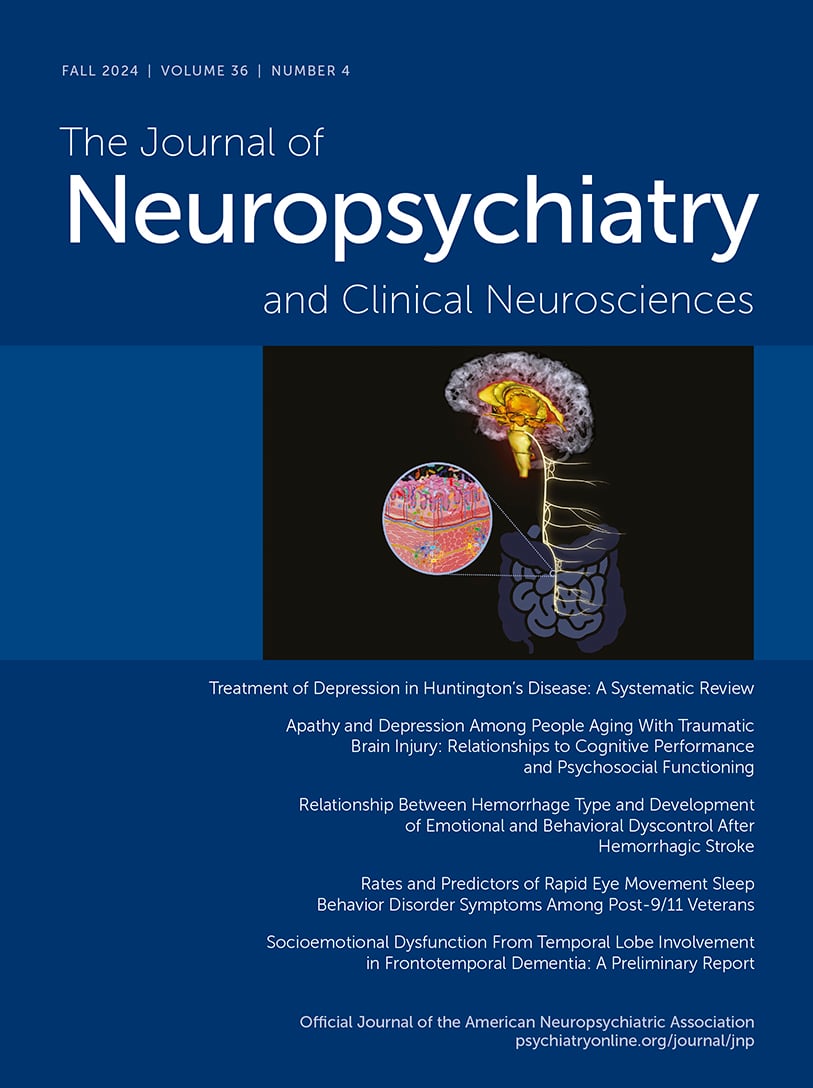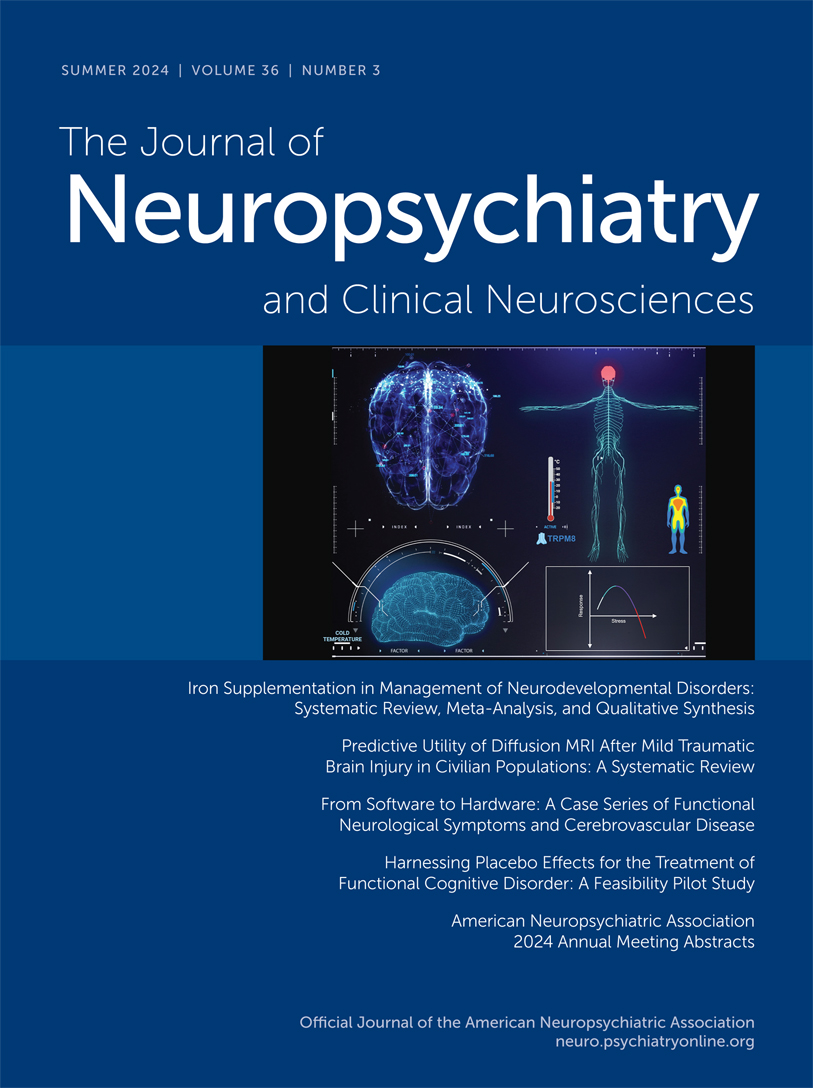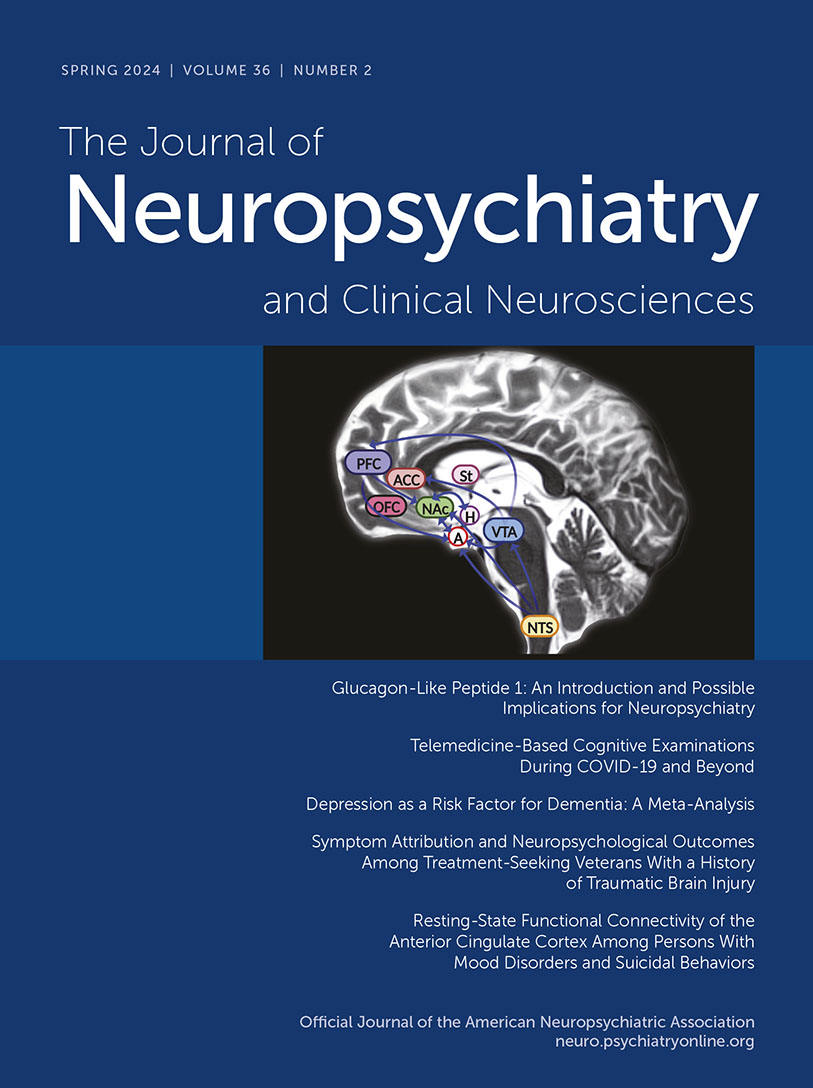The Journal of Neuropsychiatry and Clinical Neurosciences
- Volume 6
- Number 4
- November 1994
Publication date: 01 November 1994
Pages343–347In major chronic diseases, apathy or impaired executive cognitive function (ECF) can reduce the patient's ability to cope with the disease and its treatment and to maintain personal safety, dignity, and goal-directed activity. Psychometric and imaging ...
https://doi.org/10.1176/jnp.6.4.343Publication date: 01 November 1994
Pages348–357Recent advances in anatomical, behavioral, and physiological techniques have produced new information about the nature of prefrontal function, its cellular basis, and its anatomical underpinnings in nonhuman primates. These findings are changing our views ...
https://doi.org/10.1176/jnp.6.4.348Publication date: 01 November 1994
Pages358–370Five parallel anatomic circuits link regions of the frontal cortex to the striatum, globus pallidus/substantia nigra, and thalamus. The circuits originate in the supplementary motor area, frontal eye fields, dorsolateral prefrontal region, lateral orbito-...
https://doi.org/10.1176/jnp.6.4.358Publication date: 01 November 1994
Pages371–378The two hemispheres are functionally different in ways not adequately captured by the classic distinction between linguistic and nonlinguistic processes. The right hemisphere is critical for processing novel cognitive situations. The left hemisphere is ...
https://doi.org/10.1176/jnp.6.4.371Publication date: 01 November 1994
Pages379–387This article provides a broad theoretical and clinical overview of the three regional prefrontal syndromes. An understanding of the extended neural connectivity of the prefrontal cortex provides the template for describing the three distinct prefrontal ...
https://doi.org/10.1176/jnp.6.4.379Publication date: 01 November 1994
Pages388–398Nine case descriptions illustrate the three major prefrontal syndromes seen in clinical practice: disorganized type, disinhibited type, and apathetic type. A mixture of symptoms from each subtype is usually seen, but dysfunction in one prefrontal system ...
https://doi.org/10.1176/jnp.6.4.388Publication date: 01 November 1994
Pages399–410The authors describe methods for conducting a thorough assessment of functions subserved by the frontal lobes, employing both bedside and psychometric methods of assessing frontal subsystems. Qualitative or process aspects of frontal behavior observable ...
https://doi.org/10.1176/jnp.6.4.399Publication date: 01 November 1994
Pages411–418Patients with prefrontal behavioral syndromes (dysexecutive, disinhibited, and apathetic) present a significant therapeutic challenge that demands the integration of psychopharmacologic, behavioral, and systemic interventions. Unfortunately, the ...
https://doi.org/10.1176/jnp.6.4.411Publication date: 01 November 1994
Pages419–427Many patients with schizophrenia show clinical signs of frontal lobe dysfunction, including blunted affect, difficulty with problem solving, and impoverished thinking. The authors present cytoarchitectural, neuropsychological, and functional ...
https://doi.org/10.1176/jnp.6.4.419Publication date: 01 November 1994
Pages428–442Depression is common in patients with neurological disease, particularly with diseases involving the basal ganglia. Although the mechanisms of mood disorders in these patients are poorly understood, selective neural pathways affected directly and ...
https://doi.org/10.1176/jnp.6.4.428Publication date: 01 November 1994
Pages443–454The authors review 1) the pathophysiological, neuroimaging, and neurobehavioral evidence for frontal lobe involvement in closed head injury; 2) studies elucidating the cognitive deficits and behavioral disturbance related to frontal lobe lesions ...
https://doi.org/10.1176/jnp.6.4.443Publication date: 01 November 1994
Pages455–466Contemporary research has shown that delusions are often the product of identifiable neurologic disease, particularly when the delusions have a specific theme or are confined to one topic--monosymptomatic or content- specific delusions. Although these ...
https://doi.org/10.1176/jnp.6.4.455Publication date: 01 November 1994
Pages467–477A minority of patients with obsessive-compulsive disorder (OCD) have a chronic course and extreme disability, with symptoms refractory to pharmacological and psychological treatment. Considerable uncontrolled evidence suggests such cases may respond to ...
https://doi.org/10.1176/jnp.6.4.467Article
Publication date: 01 November 1994
Page492In Figure 2 of P. Trzepacz et al., "SPECT Scan and Cognitive Findings in Subclinical Hepatic Encephalopathy" (Spring 1994; 6:170-175), the legend is incorrect. The black bars represent data for cirrhosis patients, the white bars data for normal control ...
https://doi.org/10.1176/jnp.6.4.492Past Issues
View Issues Archive
Vol. 37 | No. 1

Vol. 36 | No. 4

Vol. 36 | No. 3
